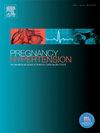高血压与孕妇子痫前期家族成员的因果关系:一项双样本孟德尔随机化研究
IF 2.9
4区 医学
Q2 OBSTETRICS & GYNECOLOGY
Pregnancy Hypertension-An International Journal of Womens Cardiovascular Health
Pub Date : 2025-05-21
DOI:10.1016/j.preghy.2025.101223
引用次数: 0
摘要
目的高血压的遗传危险因素也是子痫前期-子痫的高危因素。本研究通过双样本孟德尔随机化(MR)研究了孕妇子痫前期高血压与家庭成员高血压的关系。研究设计:孟德尔随机化。兄弟姐妹、母亲和父亲的高血压数据来自UK Biobank,分别包括364,661人、426,391人和402,899人。先兆子痫-子痫的数据为FinnGEN R9(7217例,对照组194266例)。采用反方差加权作为主要分析方法。加权中位数、MR- egger、简单模式和加权模式是互补的MR方法。异质性采用Cochran’s q检验,水平多效性采用MR-Egger回归,单核苷酸多态性(snp)采用留一法检测。结果孟德尔随机化分析显示,家族成员高血压与子痫前期-子痫风险呈正相关。兄弟姐妹有高血压的孕妇发生子痫前期-子痫的风险最高(OR = 179.41, 95% CI: 23.10 ~ 1393.65, P = 6.98E-07),其次是母亲(OR = 26.83, 95% CI: 5.42 ~ 132.87, P = 5.56E-05)和父亲(OR = 18.97, 95% CI: 1.28 ~ 281.29, P = 0.032)。MR-Egger回归检验显示无水平多效性(P >;0.05)。Cochran’s q检验显示,纳入的snp的影响表现出异质性(P <;0.05)。“留一”分析并没有揭示snp本身驱动结果。结论兄弟姐妹有高血压的孕妇发生子痫前期-子痫的风险最高,其次是母亲或父亲有高血压的孕妇。兄弟姐妹患有高血压应被视为早期预测子痫前期-子痫的高危因素。本文章由计算机程序翻译,如有差异,请以英文原文为准。
Causal association of hypertension in family members with preeclampsia-eclampsia in pregnant women: A two-sample Mendelian randomization study
Objectives
The genetic risk factors for hypertension are also high-risk factors for preeclampsia-eclampsia. This study examined the association of hypertension in family members with preeclampsia-eclampsia in pregnant women through two-sample Mendelian randomization (MR).
Study design
Mendelian randomization.
Main outcome measures
The data for hypertension in siblings, mother, and father were from the UK Biobank, including 364,661, 426,391, and 402,899 individuals, respectively. The data for preeclampsia-eclampsia were FinnGEN R9 (7217 cases and 194,266 controls). Inverse-variance weighted was used as the main analysis method. Weighted median, MR-Egger, simple mode, and weighted mode were complementary MR methods. Heterogeneity was detected using Cochran’s Q-test, horizontal pleiotropy using MR-Egger regression, and driving single-nucleotide polymorphisms (SNPs) using the leave-one-out method.
Results
Mendelian randomization analysis showed that hypertension in family members was positively correlated with preeclampsia-eclampsia risk. The risk of preeclampsia-eclampsia in pregnant women who have siblings with hypertension was the highest (OR = 179.41, 95 % CI: 23.10–1393.65, P = 6.98E-07), followed by hypertension in the mothers (OR = 26.83, 95 % CI: 5.42–132.87, P = 5.56E-05) and the fathers (OR = 18.97, 95 % CI: 1.28–281.29, P = 0.032). The MR-Egger regression test indicated no horizontal pleiotropy (P > 0.05). Cochran’s Q-test showed that the effects of the included SNPs exhibited heterogeneity (P < 0.05). The leave-one-out analysis did not reveal SNPs driving the results by themselves.
Conclusion
The risk of preeclampsia-eclampsia in pregnant women who have siblings with hypertension was the highest, followed by pregnant women with a mother or father with hypertension. Having siblings with hypertension should be considered as a high-risk factor for the early prediction of preeclampsia-eclampsia.
求助全文
通过发布文献求助,成功后即可免费获取论文全文。
去求助
来源期刊

Pregnancy Hypertension-An International Journal of Womens Cardiovascular Health
OBSTETRICS & GYNECOLOGYPERIPHERAL VASCULAR-PERIPHERAL VASCULAR DISEASE
CiteScore
4.90
自引率
0.00%
发文量
127
期刊介绍:
Pregnancy Hypertension: An International Journal of Women''s Cardiovascular Health aims to stimulate research in the field of hypertension in pregnancy, disseminate the useful results of such research, and advance education in the field.
We publish articles pertaining to human and animal blood pressure during gestation, hypertension during gestation including physiology of circulatory control, pathophysiology, methodology, therapy or any other material relevant to the relationship between elevated blood pressure and pregnancy. The subtitle reflects the wider aspects of studying hypertension in pregnancy thus we also publish articles on in utero programming, nutrition, long term effects of hypertension in pregnancy on cardiovascular health and other research that helps our understanding of the etiology or consequences of hypertension in pregnancy. Case reports are not published unless of exceptional/outstanding importance to the field.
 求助内容:
求助内容: 应助结果提醒方式:
应助结果提醒方式:


